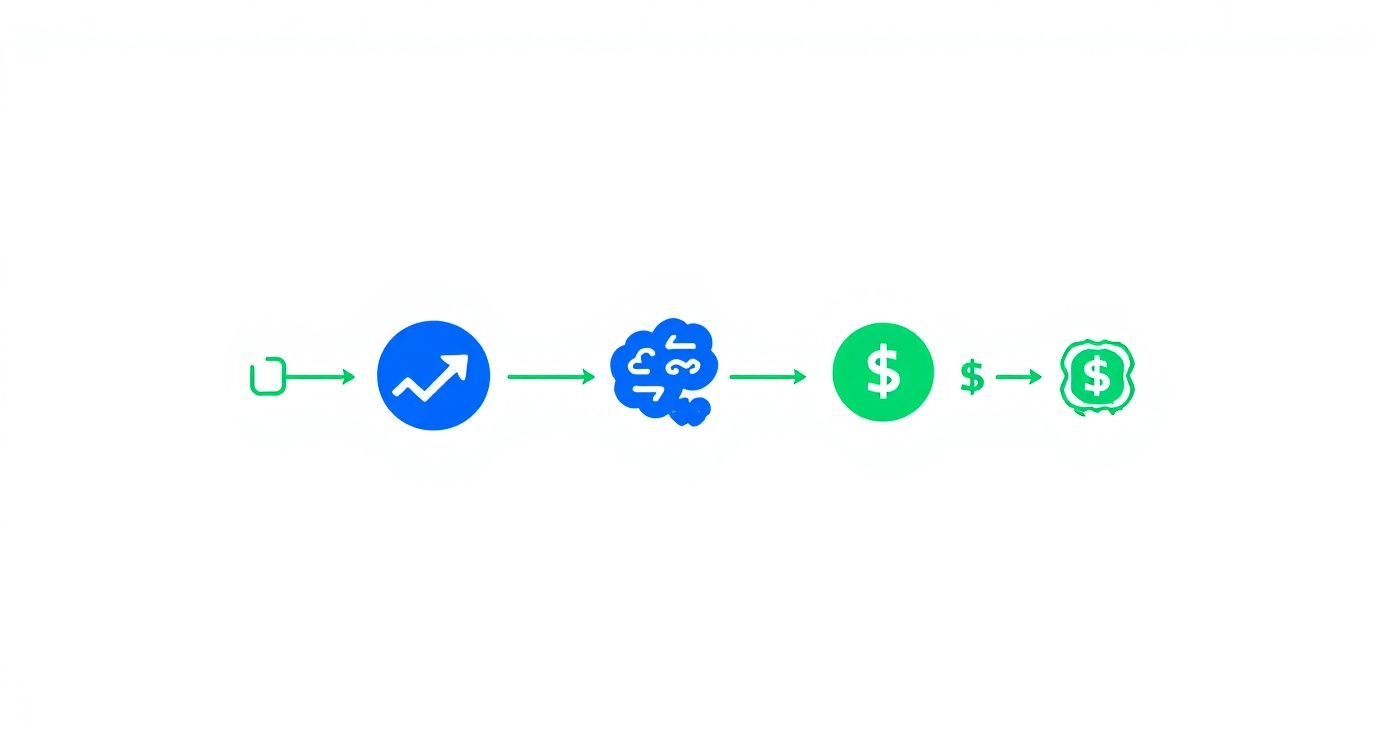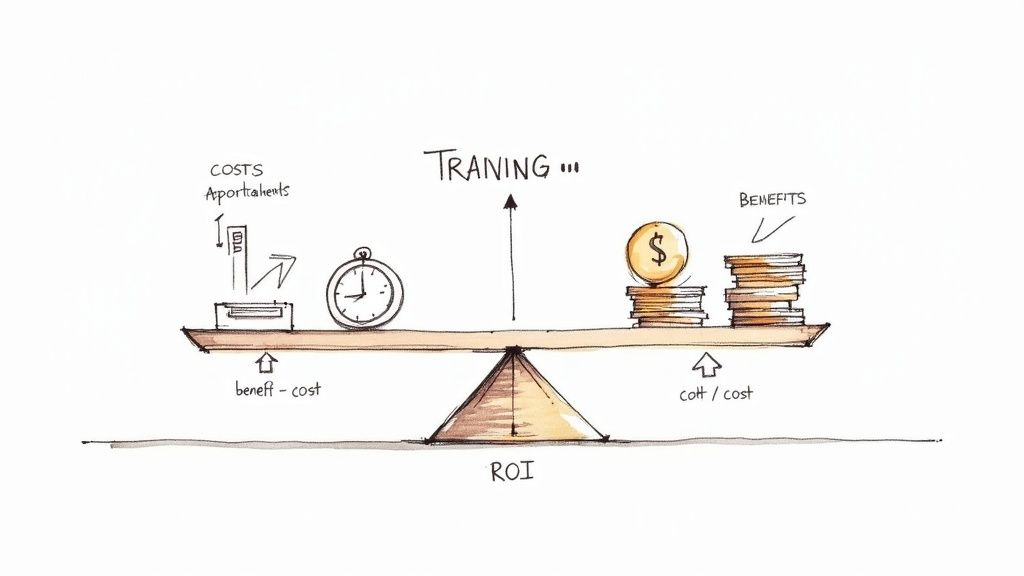
Mastering Training Effectiveness Measurement
Measuring training effectiveness is all about figuring out if your corporate training programs actually work. It goes way beyond just seeing who completed a course. The real goal is to see if the training led to genuine skill development, changes in on-the-job behavior, and a real impact on the business.
It’s the only way to prove the value and ROI of your learning and development (L&D) initiatives.
Why Your Training Measurement Strategy Needs a Rethink
Let's be honest: knowing that 95% of your sales team completed a training video is a start, but it's a vanity metric. It tells you nothing about whether they can actually close more deals, handle objections better, or contribute to revenue.
This gap between participation and performance is where so many corporate L&D departments get stuck. It leads to that frustrating cycle of high training budgets with no clear, defensible ROI. When executives start questioning the value of L&D, "everyone finished the course" is a pretty weak answer.
A modern approach flips the script, shifting the focus from inputs (like completion rates) to outcomes. It’s about building a clear, evidence-based case that connects learning activities directly to tangible business results. This is how L&D stops being seen as a cost center and becomes an indispensable driver of business growth.
Moving From Cost Center to Strategic Partner
The pressure to justify L&D spending is always on. After peaking at a staggering $101.8 billion, U.S. corporate training expenditure saw a significant drop, showing just how much scrutiny these budgets are under.
Despite this, many companies are still behind the curve on measurement. A shocking 63% still rely on infrequent, once-a-year performance reviews to figure out if training worked. That's far too slow to make meaningful improvements when they're needed. You can dig into more data on employee training statistics on eLearning Industry. This is exactly why a proactive measurement framework isn't just nice to have—it's essential for any corporate training team.
A solid strategy helps you:
- Secure Your Budget: You can walk into any meeting and confidently present data that proves the financial return of your programs.
- Improve Your Content: Using real-time data from tools like interactive video, you can pinpoint exactly where learners struggle and refine training content on the fly.
- Align with Business Goals: You can ensure every single training module is directly tied to a specific departmental or company-wide KPI.
- Demonstrate Real Value: Show leadership exactly how skill development impacts key metrics like productivity, employee retention, and customer satisfaction.
By measuring what truly matters—skill application and business results—you're not just running training programs; you're solving core business problems. This is the key to earning a strategic seat at the table.
Ultimately, the goal is to create a continuous improvement loop where data from your measurement efforts feeds right back into the design and delivery of future training. This guide will give you a step-by-step framework to build that system. And if you're looking for a head start, you can learn more about how to evaluate training effectiveness in our related guide.
Putting the Kirkpatrick Model to Work
To really figure out if your corporate training is hitting the mark, you need a solid framework. One of the most trusted and battle-tested guides out there is the Kirkpatrick Model. It’s a four-level approach that’s been the gold standard in L&D for decades, and for good reason—it gives you a clear path from the training room to real business results.
Think of it less as a rigid theory and more as a practical blueprint. It helps you blend different types of data to get the full story of your program's impact. Let's walk through each level with a real-world corporate example: imagine we're rolling out a new training program for sales reps on how to handle objections during product demos.
Level 1: Reaction — Did They Like It?
The first level, Reaction, is all about capturing immediate feedback. How did your employees feel about the training? Was it engaging? Did the content seem relevant to their daily grind?
It's easy to dismiss this step as just "happy sheets," but that's a mistake. A negative reaction is your first red flag. It can tell you that the content was off-base or the delivery just didn't connect, giving you a chance to course-correct early.
This is where modern tools like interactive video completely change the game. Instead of relying on a survey sent out days later, you can capture feelings in the moment.
- In-Video Polls: Right after a segment on a specific objection-handling technique, pop in a quick poll: "How confident do you feel using this approach?"
- Feedback Prompts: At the end of a module, ask an open-ended question: "What was the single most valuable thing you learned in this section?"
- Rating Buttons: Let learners give a quick thumbs-up or thumbs-down on different parts of the video for super-specific feedback.
With a platform like Mindstamp, you can drop these interactive elements right into your training videos. This gets you honest, immediate reactions without pulling your team out of the learning flow.
Level 2: Learning — Did They Get It?
The next level, Learning, moves beyond feelings to facts. What did your employees actually absorb from the training? Can they recall the key concepts and explain the new processes? This is where we check for actual comprehension.
For our sales team, we need to know if they truly understand the new framework for handling objections. Just watching a video doesn't prove anything. You have to test their knowledge.
Key Takeaway: Level 2 is about proving they learned it, not just proving they showed up. The best knowledge checks force learners to apply what they've learned, not just spit back facts.
This is another area where interactive video excels. You could create a short quiz that presents a common customer objection and asks the rep to pick the best response. Better yet, use Mindstamp’s branching logic to create a simulated conversation where their choice takes them down a different path, mimicking a real call. The analytics will show you not just who passed, but exactly which concepts are tripping people up.
Level 3: Behavior — Are They Using It?
Now for the big one: Behavior. Are your employees actually applying what they learned on the job? This is often the trickiest level to measure, but it's arguably the most critical. It’s the bridge between knowing and doing. For a deeper look at different ways to tackle this, check out our guide on training evaluation methods.
In our sales example, this means we need to see if the reps are using the new objection-handling techniques during their live calls.
Measurement here becomes a team sport between L&D and front-line managers.
- Manager Observations: Give sales managers a simple checklist to use when they review call recordings or join a live demo.
- CRM Data: Look for trends in your performance data. Is there a bump in demo-to-trial conversion rates?
- Peer Feedback: Create a culture of peer coaching where reps can share what’s working and offer tips to each other.
Applying the Kirkpatrick Model with Interactive Video
As you can see, the right tools make it much easier to gather the data you need at every stage, turning a theoretical model into a powerful, actionable measurement system.
Level 4: Results — Did It Move the Needle?
Finally, we arrive at Results. This level connects your training program directly to the bottom line. Did all this effort contribute to the company’s bigger goals? This is the language of the C-suite and the ultimate proof of your training's value.
This journey—from simple engagement to tangible business returns—is what it's all about.

For our sales enablement scenario, the key business results we’d be tracking might include:
- An increase in the team's overall sales quota attainment.
- A shorter average sales cycle.
- A measurable lift in the win rate for competitive deals.
By drawing a clear line from reaction and learning to behavior and, ultimately, to these high-level business metrics, you build an undeniable case for the strategic importance of your corporate training programs.
Setting Objectives That Align with Business Goals
If you think measuring training effectiveness starts with a post-course survey, you’re already behind. Real measurement begins long before your L&D team even touches a single slide or records a video. It all starts with setting razor-sharp objectives that are directly wired into what the business actually cares about.
Without this crucial first step, you're just measuring activity, not impact. You're tracking completions, not contributions.
So many corporate training programs fall flat because their goals are just too fuzzy. An objective like "improve leadership skills" sounds great, but it’s a measurement nightmare. What specific skills are we talking about? How will we know if they’ve actually improved? And most importantly, what business outcome is better leadership supposed to drive?
This kind of ambiguity makes it impossible to prove your value. Instead, every single training initiative needs to be anchored to a tangible business need. That way, every piece of data you collect later on has a clear purpose and helps you build a rock-solid case for your programs.
From Vague Goals to Specific Outcomes
The trick is to translate broad business challenges into precise, trackable learning objectives. A framework like SMART (Specific, Measurable, Achievable, Relevant, Time-Bound) is perfect for this. It's not just corporate speak; it’s a practical filter that forces you to be clear and accountable.
Let's see what this looks like in practice.
- Vague Goal: We need to improve customer support communication.
- SMART Objective: Reduce negative customer support ticket reviews (CSAT scores) related to "unclear communication" by 15% within 60 days of completing the new communication skills training.
See the difference? That revised objective gives you everything you need. You know exactly what metric to watch (CSAT scores), the specific segment to analyze (reviews mentioning communication), your target (15%), and your timeframe (60 days).
Start with the business problem first—like sinking CSAT scores—and work backward to define the training. This guarantees your efforts are focused on solving real-world issues, not just checking a box.
Connecting Training to Departmental KPIs
This same thinking applies across the entire company. The most successful L&D professionals act like internal consultants. They sit down with department heads, dig into their biggest challenges, and create training objectives that directly support their key performance indicators (KPIs).
Imagine you’re working with a few different teams. Here’s how you could tie training directly to their goals:
Getting this specific changes the entire conversation. Training is no longer a general "nice-to-have" expense. It becomes a targeted, strategic tool designed to move a specific needle.
Ultimately, this is how you build a powerful story around your results. When you can walk into a leadership meeting and say, "Our manager training directly contributed to a 10% drop in new manager turnover, saving the company an estimated $150,000 in recruitment costs," you’re no longer just talking about training. You're talking about business value.
Using Analytics to See What Learners Truly Understand
Modern training platforms are absolute goldmines of data—if you know what you’re looking for. While setting clear objectives is the foundation of any good program, your analytics dashboard is where you find out if you’re actually hitting the mark. This is where training effectiveness measurement gets real, moving from theory to tangible proof.
It’s no longer about just knowing if someone finished a training video. Now, you can see precisely what they struggled with. Interactive video platforms like Mindstamp capture a ton of data points that blow simple completion rates out of the water, giving you a crystal-clear view of learner comprehension and engagement.
Decoding Learner Behavior with Video Analytics
Every click, pause, and answer a learner provides is a breadcrumb. By following these trails, you can stop making assumptions and start gathering evidence about how your content is landing and what your team is actually absorbing.
Here are a few critical data points you should be glued to:
- Individual Question Responses: This is your most direct line to spotting knowledge gaps. If 70% of your team gets a specific question wrong about a new compliance policy, you’ve just uncovered a major misunderstanding that needs to be fixed, fast.
- Viewer Heatmaps: Heatmaps are fantastic. They show you which parts of a video are being watched, re-watched, or skipped entirely. A cluster of re-watches on a particular segment is a huge tell—that concept is either complex or you haven't explained it clearly enough.
- Engagement Drop-Off Points: Analytics can pinpoint the exact second viewers start tuning out. If you see a mass exodus halfway through a video, that's a sign. The content either needs to be more compelling or broken down into smaller, more manageable pieces.
This dashboard from Mindstamp is a great example of how you can track this stuff visually, giving you a real-time pulse on what's happening.

This kind of granular reporting lets L&D teams spot struggling learners or confusing content sections at a glance, allowing for quick, targeted interventions before a small issue becomes a big problem.
Turning Raw Numbers into Strategic Insights
Collecting data is only half the job. The real magic happens when you interpret it correctly. Your goal is to spot patterns that can inform your entire training strategy. A good analytics platform doesn’t just spit out numbers; it helps you answer the big questions about your program's impact.
For instance, you might dig into the data and discover that the sales team in one region consistently scores lower on product knowledge questions. That's not just a data point; it's a strategic insight. It tells you that this specific team might need some extra coaching or a totally different training approach.
The ultimate goal of training analytics isn't to create reports; it's to make better decisions. Use the data to refine your content, personalize learning paths, and prove the tangible impact of your efforts on employee performance.
This level of analytical rigor is quickly becoming the new standard. Recent data from Fortune 500 companies shows they're moving way beyond completion rates to measure things like ‘skill lift’—the quantifiable improvement in skills after training, which has a median of 19%. They also track ‘time to competency,’ with top firms getting employees proficient in just 14 days. You can dive deeper into these benchmarks by reading more about Fortune 500 training effectiveness on Arist.co.
When you embrace this data-driven approach, you create a powerful feedback loop. The insights you pull from your analytics directly inform how you tweak and improve your training, ensuring your programs are always evolving to meet the real-time needs of your team and the business. This transforms L&D from a one-way broadcast into a dynamic system that actually drives continuous improvement.
Calculating Training ROI to Prove Your Value

You've analyzed how learners are behaving and seen the changes on the job. Now it's time for the final piece of the puzzle: translating all that hard work into the language everyone in the C-suite understands — Return on Investment (ROI).
This isn’t just a corporate buzzword. It's how you prove your L&D program is a core business driver, not just another line item on the budget. Calculating ROI clearly shows the financial impact of your training by comparing what you gained to what you spent. A positive ROI builds an undeniable case for your team and future investments.
The Simple Formula for Training ROI
At the end of the day, ROI boils down to a single, powerful equation that any business leader can instantly grasp.
ROI (%) = (Net Program Benefits ÷ Total Program Costs) × 100
The formula itself is straightforward. The real magic, though, is in how you accurately identify and quantify everything on both sides of that equation. Getting this right is what makes your final number credible and defensible when you’re in front of stakeholders.
Tallying Up the Total Costs
First things first, you need to get a handle on every single expense tied to your training program. This means looking beyond the obvious costs and digging into all the resources that were pulled in.
Make sure you're accounting for everything, direct and indirect:
- Development Costs: Think about the hours your team poured into designing content, shooting videos, and building out assessments.
- Platform Fees: This is the cost of your learning software, like a subscription to an interactive video tool like Mindstamp.
- Facilitator and SME Time: Don't forget the salaries of instructors or subject matter experts who helped deliver the training.
- Employee Time: This one is huge. Calculate the cost of employees' salaries for the time they spent in training instead of their day-to-day work.
- Materials and Tools: Any software licenses, physical workbooks, or other resources needed for the program go here.
Add it all up, and you’ve got your Total Program Costs.
Quantifying the Financial Benefits
This can feel like the trickiest part, but it's where your story really comes to life. You need to draw a clear line from the behavioral changes you measured to tangible business results that have a real dollar value.
Start with the key business metrics your training was meant to impact.
- Increased Sales Revenue: If your new sales training led to a 5% bump in deal closure rates, you can calculate that direct revenue gain.
- Efficiency Savings: Did a process training cut down the time it takes to complete a task? Just multiply the hours saved across the team by their average salary to find the value.
- Reduced Employee Turnover: Figure out what it costs to replace an employee (recruitment, onboarding, lost productivity) and multiply that by the reduction in churn you achieved.
- Fewer Compliance Fines: If your compliance training helped the company avoid costly errors or penalties, that’s a direct and massive financial win.
These principles for tying actions to financial outcomes aren't unique to L&D. For another perspective, check out this guide on how to measure marketing ROI.
Case Study: Software Adoption ROI
Let's walk through a common scenario. Imagine a company rolls out new project management software to make their teams more efficient.
Costs:
After adding up software licenses, training development hours, and the time employees spent in the training, the total cost comes to $50,000.
Benefits:
After the training, the project management team reports they're spending 10% less time on administrative tasks. That efficiency boost saves the company an estimated $80,000 a year in employee time.
Calculation:
- Net Benefits: $80,000 (Gains) - $50,000 (Costs) = $30,000
- ROI: ($30,000 / $50,000) × 100 = 60%
A 60% ROI tells a fantastic story. It means for every single dollar the company invested in this training, it got that dollar back plus an extra 60 cents. When you present your results, lead with that big number. Then, use your data to show exactly how your L&D program made it happen.
Common Questions on Measuring Training Effectiveness
Even with the best frameworks and analytics in hand, the real world always throws a few curveballs when you're trying to pin down training effectiveness. Getting out ahead of these common hurdles can be the difference between a smooth, insightful strategy and one that just spins its wheels.
Let's tackle some of the most frequent questions that come up for L&D professionals.
How Often Should We Measure Training Effectiveness?
The short answer? It's not a one-and-done thing. Measurement isn't a final exam you give at the end of a course; it's a continuous process that should be woven into the entire lifecycle of your training. The right frequency really depends on what you’re trying to find out.
Think of it in layers, a lot like the Kirkpatrick Model:
- Immediate Feedback (Level 1): You want to capture this right away. Collect it the moment the training ends, or even better, during the training itself using things like in-video polls. This is when the learner's gut reaction is freshest.
- Knowledge Checks (Level 2): It’s standard to assess knowledge right after the training, but the real test is retention. Don't stop at the post-test. Sending a follow-up quiz after 30 or 60 days is a game-changer for seeing what information actually stuck.
- Behavioral Change (Level 3): This one takes a little patience. You can’t expect employees to change overnight. Start looking for on-the-job application a few weeks after the training wraps up, and keep an eye on things for a few months to see if the new habits are holding.
- Business Impact (Level 4): Since big-picture business KPIs move a lot slower, measuring bottom-line results is best done quarterly or even semi-annually. This gives the training's effects enough time to ripple out and actually show up in the numbers.
What's the Difference Between Training Effectiveness and Efficiency?
People often use these terms interchangeably, but they're measuring two very different, though equally important, things. Think of them as two sides of the same coin; you absolutely need both for a successful L&D program.
Training efficiency is all about your resources. It asks, "Did we deliver this training well?" The metrics here are things like cost-per-learner, the time it took to develop the course, or how many employees you pushed through the program in a quarter. It’s about being fast and staying on budget.
Training effectiveness, on the other hand, is purely about the outcome. It asks the much bigger question: "Did the training actually work?" Did it create real value? A program can be incredibly efficient—cheap to produce and rolled out in record time—but be completely ineffective if nobody learned a thing or changed their behavior. The goal is to hit that sweet spot where you're both efficient and effective.
It's easy to get caught up in delivering training quickly and cheaply. But if it doesn't solve the underlying business problem, all you've done is efficiently waste everyone's time.
How Can I Measure the Effectiveness of Soft Skills Training?
This is the big one. Measuring "soft" skills like leadership, communication, or teamwork can feel like trying to nail Jell-O to a wall. But it's entirely possible—you just have to get a bit more creative than you would with technical skills training.
A multi-layered approach is your best bet. Start with simple pre- and post-training self-assessments to get a baseline for how confident and knowledgeable employees feel. Then, layer on 360-degree feedback from peers, managers, and direct reports who are in the best position to observe real behavioral changes. You can also use scenario-based questions inside your interactive videos to see how learners react to simulated workplace challenges.
Finally, you have to connect the dots back to business metrics influenced by these skills. For a great deep-dive on how to systematically evaluate your programs, check out this practical guide to measuring training effectiveness. This could mean tracking an uptick in employee engagement scores, better customer satisfaction ratings, or even a measurable drop in team conflicts.
Ready to move beyond simple completion rates and start measuring what really matters? With Mindstamp, you can embed questions, polls, and all kinds of interactive elements directly into your training videos. It makes capturing the data you need to prove your impact almost effortless. Discover how Mindstamp can transform your training measurement strategy today.
Get Started Now
Mindstamp is easy to use, incredibly capable, and supported by an amazing team. Join us!



Try Mindstamp Free










